The Brazos Review: AMD's E-350 Supplants ION for mini-ITX
by Anand Lal Shimpi on January 27, 2011 6:08 PM ESTAMD has been curiously absent from the value netbook and nettop segments since Atom’s arrival nearly three years ago. These markets are highly profitable only for component vendors, as the OEMs that sell netbooks and nettops must survive on very slim margins in order to hit aggressive price points. It wasn’t too long ago that we were shocked by $699 desktop PCs, but to now be able to get a fully functioning portable PC with display at below $300 is impressive. In order for the profit equation to work out however, you can’t simply scale down a larger chip - you need an architecture targeted specifically at the type of very light workloads you expect to encounter in these segments. Underclocking and undervolting an architecture targeted at high end desktops or servers won’t cut it.
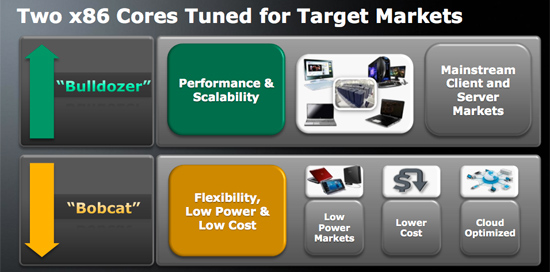
Generally a single microprocessor architecture can cover an order of magnitude of power envelopes. You can take an architecture from 10W - 100W using clock speed, voltage scaling and disabling features (e.g. cutting cache sizes). You can’t efficiently take a 100W architecture and scale it down to 1W. Intel realized this with Atom, and what resulted was a new architecture designed to span the 0.5W - 5W range. Given the constraints of the process (Atom was built at 45nm) and a desire to keep die size down to a minimum (and thus maximize profits), Intel went with a dual-issue in-order architecture reminiscent of the old Pentium - but with a modern twist.
AMD came to the same realization. For it to compete in these value markets, AMD couldn’t rely on its existing Phenom II derived architectures. The Phenom II and its relatives currently span a range of TDPs from 9W to 140W, and at the lower end of that spectrum we’re talking about some very low clock speeds and performance targets. Getting down to 1W was out of the question without a separate design.
What AMD came up with was a core called Bobcat, initially targeted for netbooks, notebooks, nettops and entry level desktops. Architecturally Bobcat is a significant step ahead of Atom: while still dual-issue, it features an out-of-order execution engine making it the Pentium Pro to Atom’s Pentium.
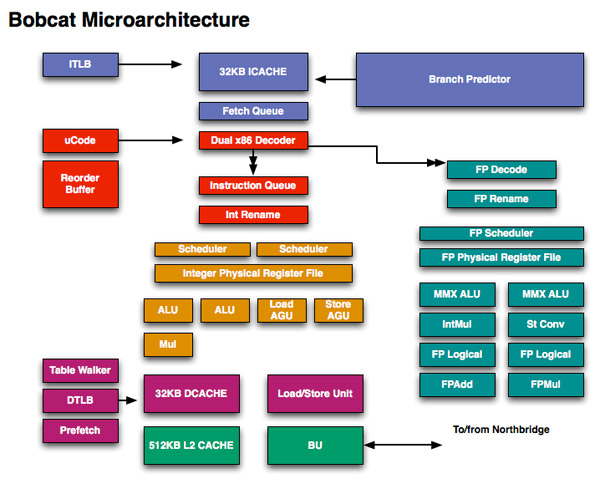
It isn’t just CPU architecture that AMD surpassed Atom with, the first incarnation of Bobcat is an integrated SoC with on-die DirectX 11 GPU. AMD calls this combination a Fusion APU (Accelerated Processing Unit) as it places both a CPU and GPU on a single die. The possible CPU/GPU combinations for Bobcat based APUs are listed in the table below:
| AMD Brazos Lineup | ||||||||
| APU Model | Number of Bobcat Cores | CPU Clock Speed | GPU | Number of GPU Cores | GPU Clock Speed | TDP | ||
| AMD E-350 | 2 | 1.6GHz | Radeon HD 6310 | 80 | 500MHz | 18W | ||
| AMD E-240 | 1 | 1.5GHz | Radeon HD 6310 | 80 | 500MHz | 18W | ||
| AMD C-50 | 2 | 1.0GHz | Radeon HD 6250 | 80 | 280MHz | 9W | ||
| AMD C-30 | 1 | 1.2GHz | Radeon HD 6250 | 80 | 280MHz | 9W | ||
AMD avoided branding its first APUs, they’re simply the AMD E-series and C-series Fusion APUs. The emphasis isn’t on the CPU or the GPU in this case, just the company name and a model number.
| CPU Specification Comparison | ||||||||
| CPU | Manufacturing Process | Cores | Transistor Count | Die Size | ||||
| AMD Zacate | 40nm | 2 | ? | 75 mm2 | ||||
| AMD Thuban 6C | 45nm | 6 | 904M | 346mm2 | ||||
| AMD Deneb 4C | 45nm | 4 | 758M | 258mm2 | ||||
| Intel Gulftown 6C | 32nm | 6 | 1.17B | 240mm2 | ||||
| Intel Nehalem/Bloomfield 4C | 45nm | 4 | 731M | 263mm2 | ||||
| Intel Sandy Bridge 4C | 32nm | 4 | 995M | 216mm2 | ||||
| Intel Lynnfield 4C | 45nm | 4 | 774M | 296mm2 | ||||
| Intel Clarkdale 2C | 32nm | 2 | 384M | 81mm2 | ||||
| Intel Sandy Bridge 2C (GT1) | 32nm | 2 | 504M | 131mm2 | ||||
| Intel Sandy Bridge 2C (GT2) | 32nm | 2 | 624M | 149mm2 | ||||
These APUs do need the aid of an additional chip - the Hudson Fusion Controller Hub (FCH). The FCH adds support for things like SATA, USB, Ethernet and Audio.The Hudson FCH is very tiny measuring approximately 4mm x 7mm for a total die size of around 28mm2.
The combination of these Bobcat based APUs and the FCH is called the Brazos platform.
Late last year AMD invited me to spend several hours with a Brazos system at its brand new campus in Austin, TX. While the preview gave us some insight into what we could expect from Brazos, I didn’t have enough time to really dive in as much as I would’ve liked to.
Earlier this month, AMD officially launched Brazos with hardware expected sometime this quarter. For the past couple of weeks I’ve been testing a Brazos mini-ITX motherboard from MSI and today, it’s time to break the silence and share the results. They are quite good.


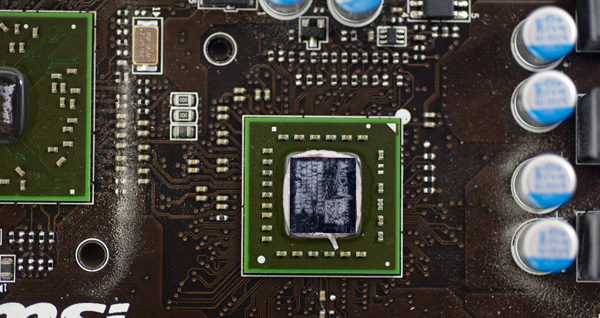
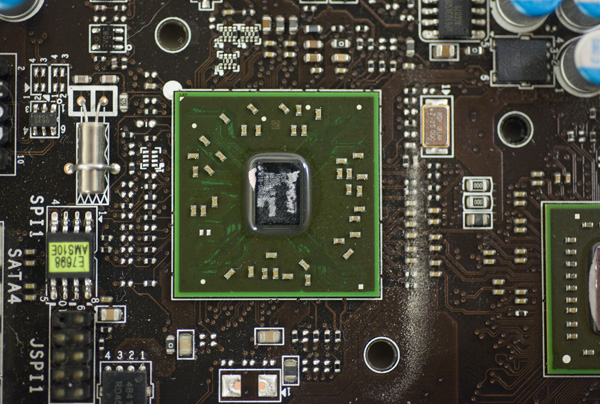
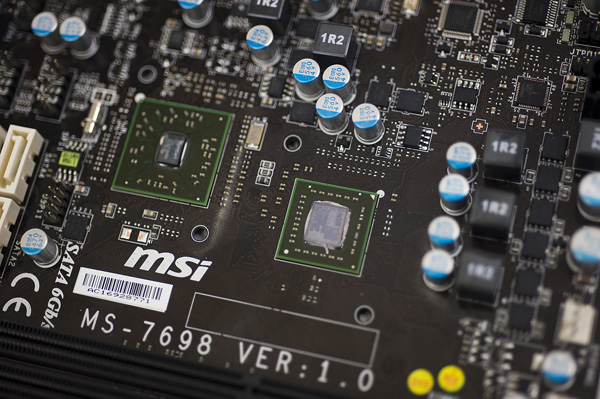
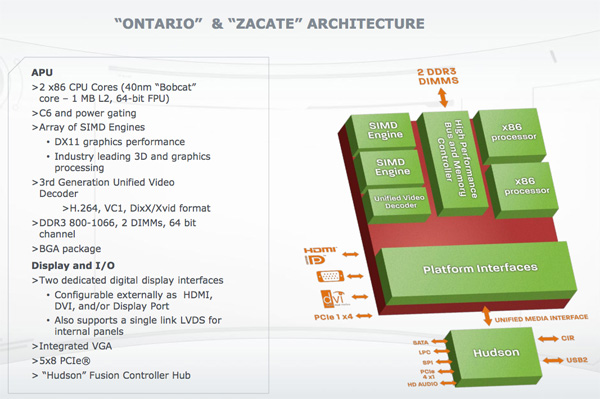








176 Comments
View All Comments
Silver47 - Friday, January 28, 2011 - link
Surely by then Anand AMD would be starting to show off the next gen Bobcat?Are Intel factoring this in and going to try and compete with the next gen, because if not they would look rather silly having a better performing part for a few months and AMD come along and crash the party?
Anand Lal Shimpi - Friday, January 28, 2011 - link
AMD indicated we should see it follow a ~12 month cadence with Brazos and its successors. Assuming perfect execution that would mean we'd see the followup in Q1 2012.The next-gen Atom part is just going to run at a faster frequency and have better media functionality (e.g. H.264 decode). I believe Intel is one more generation away from a significant performance boost with Atom.
Take care,
Anand
Tralalak - Friday, January 28, 2011 - link
VIAl's 40nm Nano X2 (Eden X2) with all-in-one chipset VIA VX900 MSP = VIA EPIA M900 Mini-ITX Q2 2011 (04/2011).VIA's 40nm next all-in-one chipset VIA VX MSP with DirectX 11 IGP refresh will appear in Q4 2011.
SilentSin - Thursday, January 27, 2011 - link
Don't mean to nitpick as I think you meant 5570 due to the market this board is aiming, but on page 5 when you added a discrete GPU did you use a 5770 or a 5570? The paragraph text switches back and forth, graph shows 5570.Anand Lal Shimpi - Thursday, January 27, 2011 - link
Thanks for the correction - it's 5570 :)Take care,
Anand
Silver47 - Friday, January 28, 2011 - link
"3, 4, 7""5 sir!"
"5!"
strikeback03 - Friday, January 28, 2011 - link
I thought the number of the counting shall be three?jnmfox - Thursday, January 27, 2011 - link
Would this be powerful enough for HDTV playback with Sage TV?"For HDTV Playback: 3Ghz processor or higher or a slower processor in combination with a video card utilizing DXVA support and using a decoder which supports DXVA"
http://www.sagetv.com/requirements.html?sageSub=tv
TiA!
QChronoD - Thursday, January 27, 2011 - link
I realize that this review was for an ITX board, but what would you guys say are the odds of this chip (or something with equal performance) shipping in the next few months in a thin and light laptop?Also could you do a quick test of minecraft? The ION 3D you reviewed the other week was passable and it seems like this is faster, but you never know...
djfourmoney - Friday, January 28, 2011 - link
Several were shown with the announcement of the HD6990 - http://www.hardwarezone.com/features/view/131493